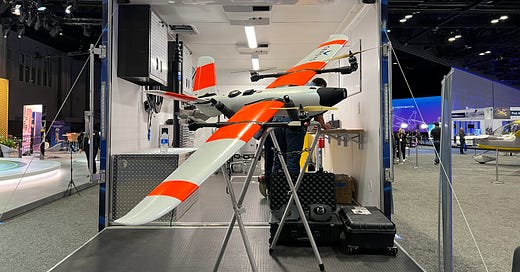The FAA’s Next Step: Understanding the Potential NPRM for Part 108 and Its Impact on Drone Operations
The Federal Aviation Administration (FAA) continues to refine and expand its regulatory framework to ensure the safe integration of drones into the National Airspace System (NAS). One of the most anticipated developments on the horizon is a Notice of Proposed Rulemaking (NPRM) for Part 108, which is expected to address certain advanced drone operations. In this article, we’ll explore the FAA’s processes, the Advisory Rulemaking Committee (ARC) and its role, what an NPRM is, the current state of drone regulations, and the potential impacts and timeframe of Part 108.
The FAA and its Role in Drone Regulation
The FAA is responsible for ensuring the safety and efficiency of the NAS, which includes manned and unmanned aircraft alike. As drone technology evolves, so too must the FAA’s regulatory framework. Recent years have seen the FAA focusing on integrating drones while maintaining safety and privacy concerns. Key steps include the establishment of Part 107 for commercial drone operations and the Remote ID rule to enhance accountability.
What is the ARC and the ARC Report?
To develop forward-looking rules, the FAA often convenes an Advisory Rulemaking Committee (ARC)—a group composed of industry stakeholders, government representatives, and experts. The ARC provides recommendations to the FAA on potential regulations. A report was released by the BVLOS ARC on March 10th, 2022.
For Part 108, the BVLOS ARC studied key issues such as:
Beyond Visual Line of Sight (BVLOS) operations.
Operations over people and moving vehicles.
Expanded use cases in urban environments.
The safe integration of emerging technologies like detect-and-avoid systems.
The ARC’s report serves as a roadmap for the FAA when drafting an NPRM, though the FAA is not obligated to adopt all of its recommendations.
What is an NPRM?
A Notice of Proposed Rulemaking (NPRM) is the FAA’s formal proposal for new regulations or amendments to existing ones. It marks the beginning of the public rulemaking process. Once the NPRM is published in the Federal Register, stakeholders, including drone operators, companies, and the general public, have the opportunity to provide feedback during a public comment period. The FAA reviews this feedback before finalizing the rule.
An NPRM for Part 108 would likely outline specific operational guidelines, certification requirements, and technological standards for advanced drone operations.
Current Drone Regulation: The Foundation
Under Part 107, the FAA allows commercial drone operations with limitations, such as:
Operations must remain within the Visual Line of Sight (VLOS) of the operator.
Maximum altitude is 400 feet above ground level.
Operations over people or moving vehicles are restricted unless a waiver is granted.
Part 107 waivers have paved the way for testing more advanced operations, such as BVLOS and nighttime flights, but these waivers are case-by-case and not scalable.
The Remote ID rule, effective in 2023, requires drones to broadcast their location and identification information, addressing safety and security concerns and laying the groundwork for broader integration.
What Could Part 108 Address?
Part 108 is expected to focus on enabling routine advanced drone operations, including:
Beyond Visual Line of Sight (BVLOS):
Establishing standardized requirements for operations where the pilot cannot see the drone directly, crucial for applications like package delivery and large-area inspections.Operations Over People and Vehicles:
Expanding the ability to fly over urban areas safely through risk-based thresholds and technology requirements.Operational Safety Standards:
Requirements for detect-and-avoid systems, command-and-control link reliability, and contingency planning.Operator and Aircraft Certification:
Introducing certification processes for certain drones and operators, similar to manned aviation standards.
A Censys Sentaero BVLOS at 2022 NBAA-BACE. Photo Credit: ZLEA
Potential Impacts of Part 108
The implications of Part 108 could be transformative:
Economic Growth
Unlocking routine BVLOS and urban operations could accelerate growth in industries such as logistics, agriculture, infrastructure inspection, and public safety.
Job Creation
As advanced drone use cases proliferate, demand for skilled drone pilots, technicians, and support staff will rise.
Regulatory Burden
While the rule could create new opportunities, it may also impose additional compliance costs on operators and manufacturers, especially smaller businesses.
Safety and Public Perception
Part 108’s emphasis on safety standards may alleviate public concerns about privacy and accidents, fostering greater acceptance of drones in daily life.
Timeframe Expectations
While the FAA has not announced a specific timeline for the Part 108 NPRM, past regulatory processes offer clues. Here’s what to expect:
NPRM Publication:
Once drafted, the NPRM will be published in the Federal Register, likely in late 2024 or early 2025.Public Comment Period:
Following the NPRM, a comment period (usually 60-90 days) will allow stakeholders to provide input.Final Rule Publication:
After reviewing comments, the FAA may take an additional 12-18 months to issue the final rule. A Part 108 rule could therefore go into effect in 2026 or 2027.
Conclusion: A Defining Moment for Drone Operations
Part 108 represents a critical step forward for the drone industry, moving from limited operations to a future where drones can perform complex, scalable missions safely and efficiently. However, achieving this vision requires careful balancing of innovation, safety, and public trust.
Drone operators, industry stakeholders, and hobbyists should stay informed and ready to participate in the NPRM process to help shape this pivotal regulation. By doing so, they can ensure that the next era of drone integration aligns with both industry needs and societal expectations.
Stay tuned for updates on the FAA’s progress as we await the release of this groundbreaking NPRM.
Copyright © WH Intellectual Properties, LLC. All rights reserved.




